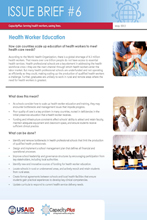
How Can Countries Scale Up Education of Health Workers to Meet Health Care Needs?
CapacityPlus announces the publication of Issue Brief #6, Health Worker Education. This brief presents an overview of issues related to the production and training of health workers with suggested actions, key considerations, and resources. According to the World Health Organization, there is a global shortage of 4.3 million health workers. That means over one billion people do not have access to essential health services. Health professional schools are a key element in addressing the health workforce crisis—they are the main channel through which health workers enter the labor market. But many health professional schools are underfunded and not operating as efficiently as they could, making scaling up the production of qualified health workers a challenge. Further, graduates are unlikely to work in rural and remote areas where the need for health workers is greatest.
According to the World Health Organization, there is a global shortage of 4.3 million health workers. That means over one billion people do not have access to essential health services. Health professional schools are a key element in addressing the health workforce crisis—they are the main channel through which health workers enter the labor market. But many health professional schools are underfunded and not operating as efficiently as they could, making scaling up the production of qualified health workers a challenge. Further, graduates are unlikely to work in rural and remote areas where the need for health workers is greatest.
What does this mean?
- As schools consider how to scale up health worker education and training, they may encounter bottlenecks and management issues that impede progress.
- Poor quality of care is a key problem in many countries, rooted in deficiencies in the initial preservice education that a health worker receives.
- Funding and infrastructure constraints affect schools’ ability to attract and retain faculty, maintain adequate equipment and classroom space, and ensure students receive sufficient clinical practice.
What can be done?
- Identify and remove bottlenecks in health professional schools that limit the production of qualified health professionals.
- Design and implement a school management plan that defines all financial and operational processes.
- Improve school leadership and governance structures by encouraging participation from key stakeholders, including local authorities.
- Identify new and innovative sources of funding for health worker education.
- Locate schools in rural or underserved areas, and actively recruit and retain students from rural areas.
- Create formal agreements between schools and local health facilities that ensure students gain practical experiences to develop key clinical competencies.
- Update curricula to respond to current health service delivery needs.
- Include long-term programs for the education, training, recruitment, and retention of faculty in the national human resources for health plan.
- Create networks among schools for knowledge-sharing and to promote the exchange of faculty, students, and medical equipment.
Key considerations
- Health professional school reform has primarily focused on curriculum improvement and faculty development. Although these approaches may improve the quality of graduates, they rarely result in an increase in graduates.
- The private sector plays an important role in the training of health workers, but how significant this contribution is and how to encourage greater participation has not been adequately addressed.
- Faith-based schools have an excellent record of training health workers that serve in rural areas. They are more likely than public-sector schools to be located outside the capital city, have clinical training sites in underserved communities, and are able to recruit students with rural backgrounds and a high degree of social service commitment.
See Issue Brief #6 for selected resources and more information. Previous CapacityPlus Issue Briefs focus on the topics of retention, health worker information systems, HR management, faith-based organizations, and community health workers.
Related items:


